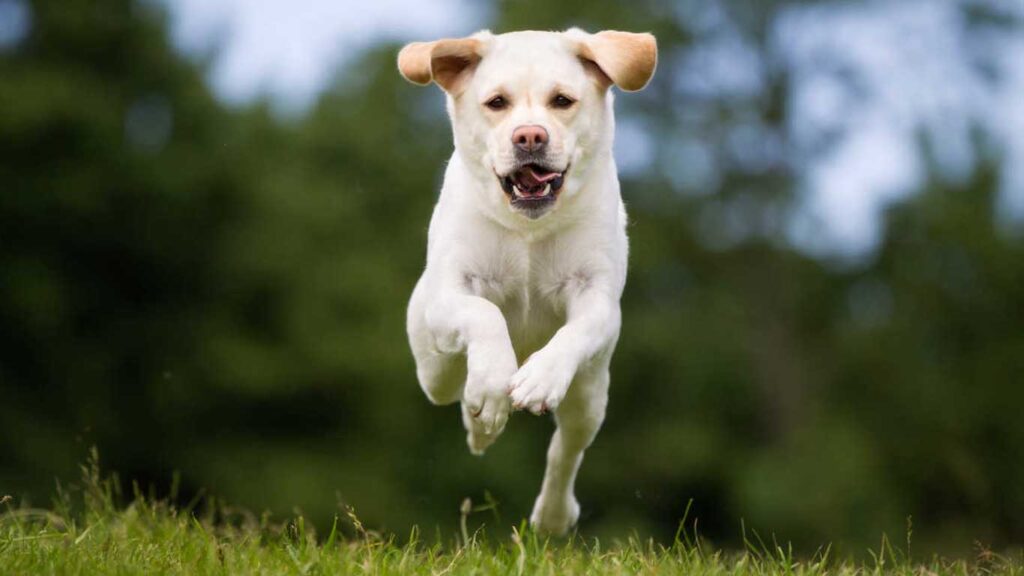Labradors are a popular dog breed known for their friendly and affectionate nature. However, despite this, they were bred for their hunting instincts and have a natural drive to chase and retrieve prey.
Labradors will not kill cats or other animals as long as they’re properly socialized and trained. However, their natural prey drive sometimes leads to aggressive behavior, especially towards smaller animals like cats or birds. Occasionally, they may even kill an animal they perceive as prey.
This article explores a labrador’s prey drive, their interactions with their owner and other animals, and how to teach labradors to coexist peacefully with other animals.
Do Labradors Attack Other Animals?
Like any other dog breed, labradors have natural instincts that can lead to aggressive behavior toward other animals.
A labrador has a prey drive that may push them to instinctively chase small animals like cats, rabbits, and squirrels.
There have been several reports of labradors attacking smaller animals. In one attack, a Labrador killed a smaller dog. In a second report, a different labrador attacked a smaller dog on a leash. However, the small dog was able to walk away.
There are several reasons why a labrador may attack another animal.
- Prey drive. As mentioned earlier, it’s natural for a labrador to hunt and chase. This drive kicks in when smaller animals run away, causing the labrador to give chase and potentially attack the smaller animal.
- Anxiety or fear. Most animals tend to react when they feel threatened or scared, and a labrador is no different. They will lash out at other animals in self-defense when threatened or scared.
- Territorial behavior. Labradors may attack another animal if they feel their territory is being invaded. This happens when the other animal approaches a labrador’s food, toys, or bedding.
- Poor socialization. If a labrador has not been properly socialized to be around other pets or animals, it may feel the need to attack. Socialized labradors handle being around other animals better.
- Health issues. A labrador may exhibit aggressive behavior due to an underlying medical condition. Studies show that dogs can exhibit aggressive behavior when sick or in pain.
Do Labradors Attack Their Owners?
Even though there are some incidences of a labrador attacking its owners, it is rare for this to occur randomly.
Generally, labradors are a friendly breed known for being even-tempered and well-behaved. However, a labrador can attack its owner if they feel threatened or scared.
There are a few circumstances under which a labrador may attack its owner.
- Fear or anxiety. A labrador may attack its owner if they feel anxious or scared. The dog may feel threatened and lash out if they are in a new environment. The labrador can also show aggression if the owner is unfamiliar or if it was recently adopted.
- Pain or discomfort. A labrador may act aggressively towards its owner if they are in pain or discomfort, especially if they perceive the owner as contributing to that pain. This can happen if the owner touches a sore joint or injects them medication.
- Dominance issues. A labrador may attack its owner if it feels like its status as pack leader is threatened. Becoming aggressive is their way of asserting dominance over their owner.
- Lack of socialization or training. Without proper training or socialization, a labrador may not know how to interact properly with its owner. This will lead to aggressiveness as it feels threatened or uncomfortable.
It is important to note that any dog may attack under the circumstances mentioned above. It is not limited to labradors alone. Proper training, socialization, and supervision can help lower the chances of a labrador attacking their owner.

Warning Signs of Aggression in Labradors
It is important to pick up on tell-tale signs that show a labrador feels uncomfortable. This helps prevent a difficult situation from escalating. Early signs that a labrador is feeling uncomfortable include:
- Moving or turning away
- Nose licking
- Yawning
- Dilated pupils
When these signs are ignored and a labrador continues to feel uncomfortable or threatened, it will exhibit stronger signs. Below are the warning signs of aggression to look out for in a Labrador.
- Barking or growling. This is one of the most obvious indications that a Labrador is becoming agitated or threatened. Growling may accompany other signs, such as flattened ears and hard stares.
- Showing teeth. You’ll notice a labrador baring teeth as a sign that it is feeling aggressive. It can also mean that the labrador is preparing to attack.
- Stiff body posture. When a labrador’s body is tense and rigid, it indicates that they are feeling threatened or agitated. It can also be an indication that they are preparing to attack.
- Raised hackles. If the hairs on a dog’s back or shoulders raise up, this is another common sign that a dog feels threatened.
- Lunging or snapping. A dog leaning or lunging forward indicates that it is about to attack. You’ll also notice the labrador snapping at the other animal.
- Avoidance or hiding. Sometimes, a labrador will show signs of aggression by hiding or avoiding the animal in question. This indicates they are fearful or anxious, which could lead to an attack when cornered or threatened.
Factors That Contribute to a Labrador’s Prey Drive
A labrador’s natural instinct to hunt and retrieve prey is known as their prey drive. This is linked to their history as hunting dogs, where they were mainly bred to assist hunters in retrieving game from land or water.
Several factors contribute to a labrador’s prey drive, including genetics, age, socialization, training, and environment.
Genetics
Prey drive is hereditary, and some labrador lines have stronger prey drives than others. For example, labradors bred for hunting will have stronger prey drives than those who were bred for companionship or show.
Studies show that labradors have a higher prey drive than other breeds. The same research also suggests that labradors who’ve received training have a higher prey drive than those who haven’t. This means that training can amplify a dog’s natural instincts.
Yet another study shows that labrador retrievers rank highly regarding search and rescue (SAR) activities. This is due in part to their genetic makeup.
Age
Naturally, prey drives are stronger in younger labradors because they’re still developing and exploring their environment. Prey drive is strongest during the juvenile stage (between three and six months), where they’re more curious and exploratory.
As a Labrador ages, their prey drive may change or decrease. Some dogs will lose their interest in hunting or chasing, while others will have the same level of prey drive for the rest of their lives.
Socialization
Socialization plays an important role in shaping a labrador’s prey drive. Early socialization teaches a dog appropriate behavior around other animals, which helps prevent unwanted aggressiveness.
Proper socialization teaches labradors to control their prey drive. Since it’s instinctual, it is not something that will merely go away. During socialization, dogs are exposed to different people, animals, and environments. This early exposure helps them be relaxed around other animals.
For example, introducing a labrador puppy to other animals at a young age teaches the dog to view these animals as a part of its social circle instead of as a threat. As the labrador grows, the chances of it hunting or chasing the other animals are slim.
Training
Training plays a crucial role in controlling a labrador’s prey drive. Despite prey drive being instinctual and influenced by genetics, it can still be controlled through training. Through training, dogs can learn to control their response in different situations or environments.
For example, basic training can teach your dog to obey simple commands such as “come,” “sit,” and “stay.” Such commands come in handy to prevent unwanted interactions with other animals.
Specialized training like hunting and retrieving will hone a dog’s prey drive. However, the training will also emphasize using prey drive in appropriate ways. This helps redirect the dog’s focus and energy toward positive activities and behavior.
Training is also helpful in teaching labradors appropriate socialization behavior toward other animals, such as cats. This reduces the risk of them acting aggressively or chasing down other animals.
Environment
A dog’s environment can also impact their prey drive. Factors such as living situation, daily routine, and animals frequently exposed to all impact the prey drive.
For example, labradors living in the city will have a milder prey drive than those living in the countryside. This is because the latter may have more opportunities to hunt and chase wildlife.
Similarly, if a labrador is infrequently exposed to cats or smaller dogs, it may exhibit more predatory behavior toward them. This will happen especially if the dog isn’t properly socialized to exhibit positive behavior toward these smaller animals.

Do Labradors Get Along With Cats?
Labradors can have positive relationships with cats, but this largely depends on the individual dog’s socialization and personality.
Some labradors have a higher prey drive than others, causing them to look at cats and other small animals as prey. However, with proper training and socialization, most labradors can learn to coexist peacefully with cats.
When first introducing a labrador to a cat, you must do it slowly and under supervision. Put a leash on the labrador to prevent it from suddenly lashing out or chasing the cat. Gradually increase the amount of time the cat and dog spend together. This helps build positive associations while reducing negative ones.
Even as the two animals build a relationship and grow comfortable around each other, you should never leave them unsupervised. Accidents can happen, and even the tamest and most well-mannered dog can exhibit a prey drive under certain circumstances. Also, ensure the cat has a personal and safe space it can retreat to when it feels threatened or uncomfortable.
While some labradors have a high prey drive and view cats as potential prey, most labradors can learn to peacefully coexist with cats with proper socialization, training, and supervision.
How to Have a Labrador With Other Pets
Labradors can peacefully coexist with other pets when trained well. If you’re planning on owning a labrador with other pets, you must follow several practices and precautions to ensure the safety of all the animals involved.
- Proper socialization. Socializing your labrador with other animals from a young age can help reduce aggressive behavior towards them. This is because they will view their interactions as positive and not threatening. Gradually introduce new animals to your dog to help it learn to be comfortable around them.
- Supervision. Always supervise your labrador when it’s around other pets. Even when socialized and trained to be around other pets, accidents can happen. You should be nearby to intervene should anything happen.
- Proper training. With the right training, your dog will learn not to chase or hunt other animals. Simple commands such as “come” or “stop” can teach your dog to lower its aggressiveness toward other animals.
- Safe spaces. Ensure all your pets have safe spaces to retreat when they feel threatened or uncomfortable. This can be in separate rooms, their pet houses, or in the case of cats, high perches that other animals can’t access.
- Separation. If all else fails and your labrador still has a high prey drive, it would be best to keep the pets separate. For the other animals’ safety, install baby crates or have different living areas.
- Slow introduction. As mentioned earlier, go slowly when introducing your labrador to a new pet. Over several weeks, allow them to gradually get used to each other. Even when your dog is comfortable in the presence of other animals, never leave them unsupervised.
Following the precautions mentioned above can help promote a peaceful living environment in your home.
Conclusion
Labradors will not randomly attack or kill other animals unless it feels threatened and has a higher prey drive. Even though there have been cases of labradors attacking other animals, such behavior is not indicative of the breed as a whole. Labradors are still one of the most affectionate dog breeds. Labradors can peacefully coexist with their owners and other animals with proper training and socialization.




